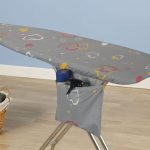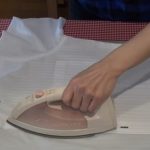What is a pressing cloth for ironing? Why do we use pressing cloth? What are pressing cloth alternatives? We know these questions may arise in your mind whenever you hear anyone talking about ironing pressing cloth or seeing someone using it.
A pressing cloth is a piece of cloth or sheet made of cotton canvas, synthetic mesh, wool, or muslin, placed between your garment and iron soleplate. Pressing cloth is also known as ironing cloth, mesh cloth, and ironing clothes protector. It is used as a protective layer to shield your clothes from any damage (like scorching, fabric shine, burning, or melting) while ironing by making direct contact with a hot iron.
Ironing Cloth Protector: Why Use a Pressing Cloth?
In This Article
1. Safeguarding Delicate Fabrics:
Protective mesh ironing cloth helps to safeguard delicate fabrics while ironing to preserve the quality of your clothes fabric. As delicate textiles are highly vulnerable to heat damage. So, when we use an ironing cloth protector it acts as a barrier between the hot iron soleplate and the garment. However, it transmits the heat in a balanced way and makes your delicate fabric garments ironing hassle-free. So, you can iron clothes without the stress of any damage.
2. Preventing Scorch Marks and Shine:
There are high chances of shiny areas and scorch marks when you iron nylon, silk, leather, and fabric containing synthetic fiber. However, when we use an ironing cloth protector it helps to prevent shine patches on the fabric by even distribution of heat in a balanced way.
Furthermore, it helps to protect the iron soleplate from scratching when ironing clothes having metal buttons and zippers. So protective cloth acts as a barrier between the metal and soleplate.
3. Avoiding Fabric Discoloration:
You heard from many experienced old people, that they don’t hang their clothes after laundry in direct sunlight. Moreover, some clothing brands specially mention in their precaution tags of garments, not to use high heat or not hang under direct sunlight. Do you know the reason why they said so?
The reason is, that some fabric materials are prone to discoloration especially when exposed to high heat. Mostly dark-colored gets light patches and a whitish tint. So, the pressing cloth preserves the original color while ironing as it distributes the balanced heat.
4. Cost Saving and Prevent Residue Build-up:
An ironing cloth protector is used between the cloth and hot iron soleplate when you are ironing clothes. So, helps to protect your iron soleplate from any residue build-up while sewing, crafting, or ironing any painted or embellished garments.
Moreover, it is cost-saving because it saves your clothes from damage, increases iron durability, and protects the soleplate from scorch marks. Furthermore, it helps to prevent the shrinking of clothes while ironing that are prone to shrinking due to heat.
How to Use a Pressing Cloth:
Using a pressing cloth is a simple process. Here’s a step-by-step guide to ensure you get the best results:
- Take a clean and dry pressing cloth according to the fabric you are going to iron.
- Set the garment on the ironing table from which you want to remove creases.
- Place the pressing cloth over the area of the garment you wish to iron.
- Adjust the iron to the appropriate temperature for the fabric.
- Press the iron gently onto the pressing cloth, moving it in the desired direction.
- Keep ironing until the wrinkles are cleared.
How to Make a Pressing Cloth
Creating your pressing cloth at home is easy and cost-effective.

Choosing the Fabric:
When selecting a pressing cloth fabric, consider the type of fabric you commonly iron. For delicate fabrics, choose a silk, organza, or muslin pressing cloth material, while a cotton pressing cloth works well for most other fabrics and materials.
Size and Shape of Pressing Cloth:
There are no such standard sizes of the pressing cloth is fixed. However, the shape mostly used is either square or rectangular. Cut the cloth to the size which you want. Mostly for the rectangular pressing cloth shape the size used is (12″ x 30″), (12″ x 30″) or (22 x 30-inch) and for square shapes (12″ x 12 inches). You can take a piece of whatever size you want. A larger pressing cloth is ideal for bigger items like dresses and shirts, while smaller ones are suitable for collars and cuffs.
You can sew the corners of the cloth or leave it with just cutting the required size.
Conclusion:
Although a pressing cloth can seem like a little addition to your ironing routine. However, it is essential for maintaining the quality and durability of your clothes. Furthermore, your clothes will always look fresh and their best if you use the appropriate pressing cloth for the job and use the right procedure.











